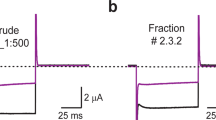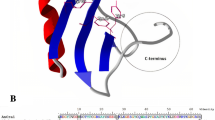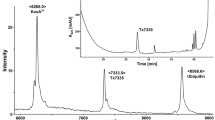Abstract
A technique has been developed for obtaining recombinant functionally active peptides Ce1 and Ce4 from the venom of the scorpion Centruroides elegans in the Escherichia coli expression system. The yields of peptides Ce1 and Ce4 were 6.5 and 12 mg per liter of culture, respectively. The properties of the obtained peptides were studied using bioengineered systems based on hybrid channels KcsA-Kv1.x (x = 1, 3, 6) containing blocker binding sites of the corresponding eukaryotic potassium channels of Kv1-family. It has been shown that recombinant Ce1 and Ce4 do not exhibit affinity to the binding sites of Kv1.1 and Kv1.6 channels up to micromolar concentrations and, like natural peptides, selectively interact with the binding site of the Kv1.3 channel: the apparent dissociation constants of KcsA-Kv1.3 complexes with recombinant Ce1 and Ce4 are 50 ± 10 and 200 ± 30 nM (mean ± SEM), respectively.

Similar content being viewed by others
REFERENCES
Jan, L.Y. and Jan, Y.N., Voltage-gated potassium channels and the diversity of electrical signalling, J. Physiol., 2012, vol. 590, no. 11, pp. 2591–2599.
González, C., Baez-Nieto, D., Valencia, I., Oyarzun, I., Rojas, P., Naranjo, D., and Latorre, R., K+ channels: function-structural overview, Comp. Physiol., 2012, vol. 2, no. 3, pp. 2087–2149.
Chow, L.W.C. and Leung, Y.M., The versatile Kv channels in the nervous system: actions beyond action potentials, Cell. Mol. Life Sci., 2020, vol. 77, no. 13, pp. 2473–2482.
Wulff, H., Castle, N.A., and Pardo, L.A., Voltage-gated potassium channels as therapeutic targets, Nat. Rev. Drug Discov., 2009, no. 12, pp. 982–1001.
Beraud, E., Viola, A., Regaya, I., Confort-Gouny, S., Siaud, P., Ibarrola, D., le Fur, Y., Barbaria, J., Pellissier, J.F., Sabatier, J.M., Medina, I., and Cozzone, P.J., Block of neural Kv1.1 potassium channels for neuroinflammatory disease therapy, Ann. Neurol., 2006, vol. 60, no. 5, pp. 586–596.
Cañas, C.A., Castano-Valencia, S., and Castro-Herrera, F., Pharmacological blockade of KV1.3 channel as a promising treatment in autoimmune diseases, J. Transl. Autoimmun., 2022, vol. 5, art. ID 100146.
Fomina, A.F., Nguyen, H.M., and Wulff, H., Kv1.3 inhibition attenuates neuroinflammation through disruption of microglial calcium signaling, Channels, 2021, vol. 15, no. 1, pp. 67–78.
Kuzmenkov, A.I., Grishin, E.V., and Vassilevski, A.A., Diversity of potassium channel ligands: focus on scorpion toxins, Biochemistry (Moscow), 2015, vol. 80, no. 13, pp. 1764–1799.
Banerjee, A., Lee, A., Campbell, E., and Mackinnon, R., Structure of a pore-blocking toxin in complex with a eukaryotic voltagedependent K+channel, Elife, 2013, no. 2, art. ID e00594.
Hu, L., Pennington, M., Jiang, Q., Whartenby, K.A., and Calabresi, P.A., Characterization of the functional properties of the voltage-gated potassium channel Kv1.3 in human CD4+ T lymphocytes, J. Immunol., 2007, vol. 179, no. 7, pp. 4563–4570.
Doczi, M.A., Morielli, A.D., and Damon, D.H., Kv1.3 channels in postganglionic sympathetic neurons: Expression, function, and modulation, Am. J. Physiol. Regul. Integr. Comp. Physiol., 2008, vol. 295, no. 3, pp. R733–R740.
Pennington, M.W., Czerwinski, A., and Norton, R.S., Peptide therapeutics from venom: Current status and potential, Bioorganic Med. Chem., 2018, vol. 26, no. 10, pp. 2738–2758.
Gubič, Š., Hendrickx, L.A., Toplak, Ž., Sterle, M., Peigneur, S., Tomašič, T., Pardo, L.A., Tytgat, J., Zega, A., and Mašič, L.P., Discovery of Kv1.3 ion channel inhibitors: Medicinal chemistry approaches and challenges, Med. Res. Rev., 2021, vol. 41, no. 4, pp. 2423–2473.
Tarcha, E.J., Olsen, C.M., Probst, P., Peckham, D., Munoz-Elias, E.J., Kruger, J.G., and Iadonato, S.P., Safety and pharmacodynamics of dalazatide, a Kv1.3 channel inhibitor, in the treatment of plaque psoriasis: A randomized phase 1b trial, PLoS One, 2017, vol. 12, no. 7, art. ID e0180762.
Rodríguez De La Vega, R.C., Merino, E., Becerril, B., and Possani, L.D., Novel interactions between K+ channels and scorpion toxins, Trends Pharmacol. Sci., 2003, vol. 24, no. 5, pp. 222–227.
Giangiacomo, K.M., Ceralde, Y., and Mullmann, T.J., Molecular basis of alpha-KTx specificity, Toxicon, 2004, vol. 43, no. 8, pp. 877–886.
Nekrasova, O.V., Volyntseva, A.D., Kudryashova, K.S., Novoseletsky, V.N., Lyapina, E.A., Illarionova, A.V., Yakimov, S.A., Korolkova, Y.V., Shaitan, K.V., Kirpichnikov, M.P., and Feofanov, A.V., Complexes of peptide blockers with Kv1.6 pore domain: molecular modeling and studies with KcsA-Kv1.6 channel, J. Neuroimmune Pharmacol., 2017, vol. 12, no. 2, pp. 260–276.
Olamendi-Portugal, T., Somodi, S., Fernandez, J.A., Zamudio, F.Z., Becerril, B., Varga, Z., Panyi, G., Gáspár, R., and Possani, L.D., Novel α-KTx peptides from the venom of the scorpion Centruroides elegans selectively blockade Kv1.3 over IKCa1 K+ channels of T cells, Toxicon, 2005, vol. 46, no. 4, pp. 418–429.
D’adamo, M.C., Liantonio, A., Rolland, J.F., Pessia, M., and Imbrici, P., Kv1.1 channelopathies: Pathophysiological mechanisms and therapeutic approaches, Int. J. Mol. Sci., 2020, vol. 21, no. 8, art. ID 2935.
Peck, L.J., Patel, R., Diaz, P., Wintle, Y.M., Dickenson, A.H., Todd, A.J., Calvo, M., and Bennett, D.L.H., Studying independent Kcna6 knock-out mice reveals toxicity of exogenous LacZ to central nociceptor terminals and differential effects of Kv1.6 on acute and neuropathic pain sensation, J. Neurosci., 2021, vol. 41, no. 44, pp. 9141–9162.
Koschak, A., Bugianesi, R.M., Mitterdorfer, J., Kaczorowski, G.J., Garcia, M.L., and Knaus, H.G., Subunit composition of brain voltage-gated potassium channels determined by hongotoxin-1, a novel peptide derived from Centruroides limbatus venom, J. Biol. Chem., 1998, vol. 273, no. 5, pp. 2639–2644.
Bartok, A., Toth, A., Somodi, S., Szanto, T.G., Hajdu, P., Panyi, G., and Varga, Z., Margatoxin is a non-selective inhibitor of human Kv1.3 K+ channels, Toxicon, 2014, vol. 87, pp. 6–16.
Grissmer, S., Nguyen, A.N., Aiyar, J., Hanson, D.C., Mather, R.J., Gutman, G.A., Karmilowicz, M.J., Auperin, D.D., and Chandy, K.G., Pharmacological characterization of five cloned voltage-gated K+ channels, types Kv1.1, 1.2, 1.3, 1.5, and 3.1, stably expressed in mammalian cell lines, Mol. Pharmacol., 1994, vol. 45, no. 6, pp. 1227–1234.
Kudryashova, K.S., Nekrasova, O.V., Kuzmenkov, A.I., Vassilevski, A.A., Ignatova, A.A., Korolkova, Y.V., Grishin, E.V., Kirpichnikov, M.P., and Feofanov, A.V., Fluorescent system based on bacterial expression of hybrid KcsA channels designed for Kv1.3 ligand screening and study, Anal. Bioanal. Chem., 2013, vol. 405, no. 7, pp. 2379–2389.
Kuzmenkov, A.I., Vassilevski, A.A., Kudryashova, K.S., Nekrasova, O.V., Peigneur, S., Tytgat, J., Feofa-nov, A.V., Kirpichnikov, M.P., and Grishin, E.V., Variability of potassium channel blockers in Mesobuthus eupeus scorpion venom with focus on Kv1.1: an integrated transcriptomic and proteomic study, J. Biol. Chem., 2015, vol. 290, no. 19, pp. 12195–12209.
Tropea, J.E., Cherry, S., and Waugh, D.S., Expression and purification of soluble His6-tagged TEV protease, in High Throughput Protein Expression and Purification, vol. 498: Methods in Molecular Biology, Doyle, S.A., Ed., Humana press, 2009, pp. 297–307.
Nekrasova, O., Kudryashova, K., Fradkov, A., Yakimov, S., Savelieva, M., Kirpichnikov, M., and Feofa-nov, A., Straightforward approach to produce recombinant scorpion toxins—Pore blockers of potassium channels, J. Biotechnol., 2017, vol. 241, pp. 127–135.
Kuipers, B.J.H. and Gruppen, H., Prediction of molar extinction coefficients ofproteins and peptides using UV absorption of the constituent amino acids at 214 nm to enable quantitative reverse phase high-performance liquidchromatography-mass spectrometry analysis, J. Agric. Food Chem., 2007, vol. 55, no. 14, pp. 5445–5451.
Orlov, N., Nekrasova, O., and Feofanov, A., Fluorescent ligands of Kv1 channels on the basis of hongotoxin: Atto488-hongotoxin, Microsc. Microanal., 2019, vol. 25, no. 2, pp. 1278–1279.
Kuzmenkov, A.I., Nekrasova, O.V., Kudryashova, K.S., Peigneur, S., Tytgat, J., Stepanov, A.V., Kirpichnikov, M.P., Grishin, E.V., Feofanov, A.V., and Vassilevski, A.A., Fluorescent protein-scorpion toxin chimera is a convenient molecular tool for studies of potassium channels, Sci. Rep., 2016, vol. 6, art. ID 33314.
Denisova, K.R., Orlov, N.A., Yakimov, S.A., Kryukova, E.A., Dolgikh, D.A., Kirpichnikov, M.P., Feofanov, A.V., and Nekrasova, O.V., GFP-margatoxin, a genetically encoded fluorescent ligand to probe affinity of Kv1.3 channel blockers, Int. J. Mol. Sci., 2022, vol. 23, no. 3, art. ID 1724.
Garcia, M.L., Garcia-Calvo, M., Hidalgo, P., Lee, A., and MacKinnon, R., Purification and characterization of three inhibitors of voltage-dependent K+ channels from Leiurus quinquestriatus var. hebraeus venom, Biochemistry, 1994, vol. 33, no. 22, pp. 6834–6839.
George Chandy K., Cahalan, M., Pennington, M., Norton, R.S., Wulff, H., and Gutman, G.A., Potassium channels in T lymphocytes: Toxins to therapeutic immunosuppressants, Toxicon, 2001, vol. 39, no. 9, pp. 1269–1276.
Legros, C., Pollmann, V., Farrell, A.M., Bougis, P.E., Martin-eauclaire, M., and Pongs, O., Generating a high affinity scorpion toxin receptor in KcsA-Kv1.3 chimeric potassium channels, Biochemistry, 2000, vol. 275, no. 22, pp. 16918–16924.
Chen, R. and Chung, S.H., Binding modes of two scorpion toxins to the voltage-gated potassium channel Kv1.3 revealed from molecular dynamics, Toxins, 2014, vol. 6, no. 7, pp. 2149–2161.
ACKNOWLEDGEMENTS
We thank Yu.V. Korolkova for providing R-AgTx2 and M.V. Serebryakova for measurements of peptide masses by mass spectrometry.
Funding
The research was funded by Russian Science Foundation, project number 19-74-30014. The research was partially performed using facilities of the Interdisciplinary Scientific and Educational School of Moscow University “Molecular Technologies of the Living Systems and Synthetic Biology.”
Author information
Authors and Affiliations
Corresponding author
Ethics declarations
COMPLIANCE WITH ETHICAL STANDARDS
The authors declare that they have no conflicts of interest. The studies were carried out without the use of animals and without involving people as subjects.
ADDITIONAL INFORMATION
Running title: Interaction of Ce1 and Ce4 Peptides with Kv1 Channels
Additional information
Translated by A. Deryabina
About this article
Cite this article
Orlov, N.A., Yakimov, S.A., Nekrasova, O.V. et al. Recombinant Peptides Ce1 and Ce4 from the Venom of Scorpion Centruroides elegans and Their Interactions with Hybrid Channels KcsA-Kv1.x (x = 1, 3, 6). Moscow Univ. Biol.Sci. Bull. 77, 119–125 (2022). https://doi.org/10.3103/S0096392522020067
Received:
Revised:
Accepted:
Published:
Issue Date:
DOI: https://doi.org/10.3103/S0096392522020067




